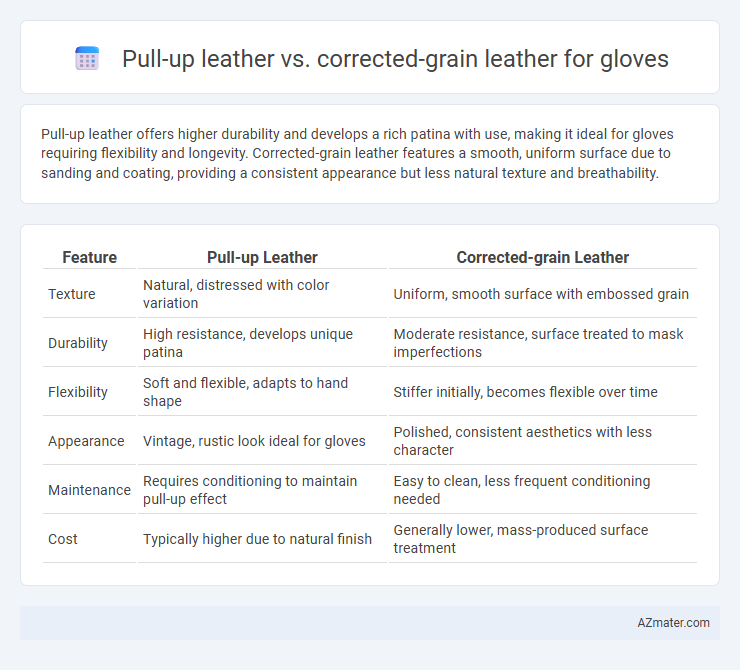Pull-up leather offers higher durability and develops a rich patina with use, making it ideal for gloves requiring flexibility and longevity. Corrected-grain leather features a smooth, uniform surface due to sanding and coating, providing a consistent appearance but less natural texture and breathability.
Table of Comparison
| Feature | Pull-up Leather | Corrected-grain Leather |
|---|---|---|
| Texture | Natural, distressed with color variation | Uniform, smooth surface with embossed grain |
| Durability | High resistance, develops unique patina | Moderate resistance, surface treated to mask imperfections |
| Flexibility | Soft and flexible, adapts to hand shape | Stiffer initially, becomes flexible over time |
| Appearance | Vintage, rustic look ideal for gloves | Polished, consistent aesthetics with less character |
| Maintenance | Requires conditioning to maintain pull-up effect | Easy to clean, less frequent conditioning needed |
| Cost | Typically higher due to natural finish | Generally lower, mass-produced surface treatment |
Introduction to Pull-Up and Corrected-Grain Leather
Pull-up leather is a durable, full-grain leather treated with oils and waxes that create a rich patina and natural creases when stretched or bent, making it ideal for gloves requiring both flexibility and rugged aesthetics. Corrected-grain leather is made from lower-quality hides with the natural grain sanded off and an artificial grain applied, resulting in a smoother, more uniform surface that is easier to clean but less breathable and less resistant to wear. For glove manufacturing, pull-up leather offers superior durability and aging characteristics, while corrected-grain leather provides consistent appearance and affordability.
Understanding Leather Grain Types
Pull-up leather, known for its natural aniline finish, exhibits a rich patina and flexibility, making it ideal for gloves requiring softness and durability. Corrected-grain leather undergoes surface sanding and embossing to mask imperfections, offering a uniform appearance but less breathability and character compared to pull-up leather. Understanding these grain types helps in selecting gloves that balance aesthetic appeal, comfort, and longevity based on their intended use.
What is Pull-Up Leather?
Pull-up leather is a type of full-grain leather known for its distinctive patina and elasticity, created by applying natural oils and waxes to the surface, which gives gloves a rich, aged look as they flex and wear. This leather maintains the hide's natural texture, offering superior durability, breathability, and comfort essential for high-performance gloves. In contrast to corrected-grain leather, which undergoes extensive sanding and coating to mask imperfections, pull-up leather preserves authenticity and character, making it a preferred choice for premium gloves requiring long-lasting resilience and softness.
Characteristics of Corrected-Grain Leather
Corrected-grain leather for gloves features a surface that has been sanded and buffed to remove imperfections, then coated with a pigment or finish, resulting in a uniform appearance and enhanced durability. This type of leather offers excellent resistance to stains and scratches but may lack the natural breathability and softness found in pull-up leather. The finish on corrected-grain leather provides consistent color and texture, making it ideal for gloves requiring a polished and durable exterior.
Durability Comparison: Pull-Up vs Corrected-Grain
Pull-up leather, known for its rich, natural finish and enhanced durability, exhibits excellent resistance to wear and tear due to its full-grain layer and wax treatments that improve flexibility and longevity in gloves. Corrected-grain leather undergoes surface sanding and artificial texturing, which can reduce its overall strength and durability compared to pull-up leather, making it more susceptible to scratches and wear under heavy use. For glove applications requiring long-term durability and resistance to abrasion, pull-up leather is generally the superior choice.
Aesthetic Differences in Glove Applications
Pull-up leather exhibits a rich, vintage aesthetic with natural color variations and a soft, supple texture that enhances glove designs through its distressed, worn-in look. Corrected-grain leather offers a smooth, uniform surface with a consistent color and finish, providing gloves a polished and professional appearance ideal for formal or high-end applications. The choice between pull-up and corrected-grain leather in gloves largely depends on the desired visual impact, where pull-up leather emphasizes character and ruggedness while corrected-grain leather prioritizes refinement and durability.
Care and Maintenance Requirements
Pull-up leather gloves require regular conditioning with oil-based leather conditioners to maintain their natural waxy finish and prevent cracking, while avoiding excessive water exposure to preserve the leather's durability and patina. Corrected-grain leather gloves demand frequent cleaning with mild soap and water solutions, followed by the application of water-resistant conditioners to ensure the surface coating remains intact and to prevent peeling or cracking. Both types benefit from proper storage away from direct sunlight and moisture to extend glove lifespan and maintain optimal flexibility and appearance.
Comfort and Flexibility for Gloves
Pull-up leather offers superior comfort and flexibility for gloves due to its natural oils and waxes that allow the material to stretch and mold to the hand over time. Corrected-grain leather, while more uniform in appearance, often sacrifices softness and pliability because of its heavy surface treatments and sanding processes. For gloves requiring a snug, break-in feel and enhanced dexterity, pull-up leather is generally preferred.
Price and Value Considerations
Pull-up leather gloves typically offer higher durability and a more natural, appealing patina over time, making them a premium choice often priced higher than corrected-grain leather gloves. Corrected-grain leather gloves undergo surface treatment to remove imperfections, resulting in a lower price point but less unique aging and character development. Consumers seeking long-term value and superior aesthetics may prefer pull-up leather despite the initial cost premium, while corrected-grain leather provides an affordable, consistent option.
Choosing the Right Leather for Gloves
Pull-up leather offers a rich, natural patina and superior flexibility, making it ideal for gloves that require durability and a broken-in feel. Corrected-grain leather provides a uniform surface with enhanced resistance to stains and scratches, suited for gloves demanding a polished look and easier maintenance. Selecting the right leather depends on whether longevity and character or consistency and protection are your primary glove priorities.

Infographic: Pull-up leather vs Corrected-grain leather for Glove
 azmater.com
azmater.com